5 KPIs to track your e-commerce store success

Published 2023-10-08
Summary - It’s important to establish your business goals, track metrics to measure how successful your e-commerce store is and optimize performance.
Pobody’s nerfect. There may be some areas of your marketing and sales strategies that are lacking. But, what are you going to do about it?
You might have some ideas that you think will make your e-commerce store more successful. But, you could just be wasting your resources.
A data-driven approach, however, removes any guesswork when it comes to reaching your business objectives. It will help you refine and optimize your strategy in a much more efficient way.
Establishing and tracking KPIs will help you make important business decisions, better understand your customers and ultimately increase your profits.
Here are five ecommerce KPIs that are most commonly used:
1. Traffic. Optimize your marketing and advertising efforts to get more site visitors.
2. Cart Abandonment. Uncover problems that prevent customers from completing a purchase.
3. AOV. Find the channels which bring big spenders to your site.
4. Conversions. Work out how to drive more sales.
5. CLV. Tweak your acquisition strategy, plus bring in more high-value customers.
Below you will find a more detailed breakdown of each KPI.
1. Traffic
The first hurdle you have to cross as an e-commerce business is getting visitors to your site. To do this, you likely use various marketing and advertising tactics. When you measure traffic, you see exactly how well these methods are working.
Online retailers get most of their traffic from organic and paid search. Yet, other channels such as email and social drive a decent amount of traffic to online stores, too:

To discover your traffic performance, head to Audience > Overview in Google Analytics:
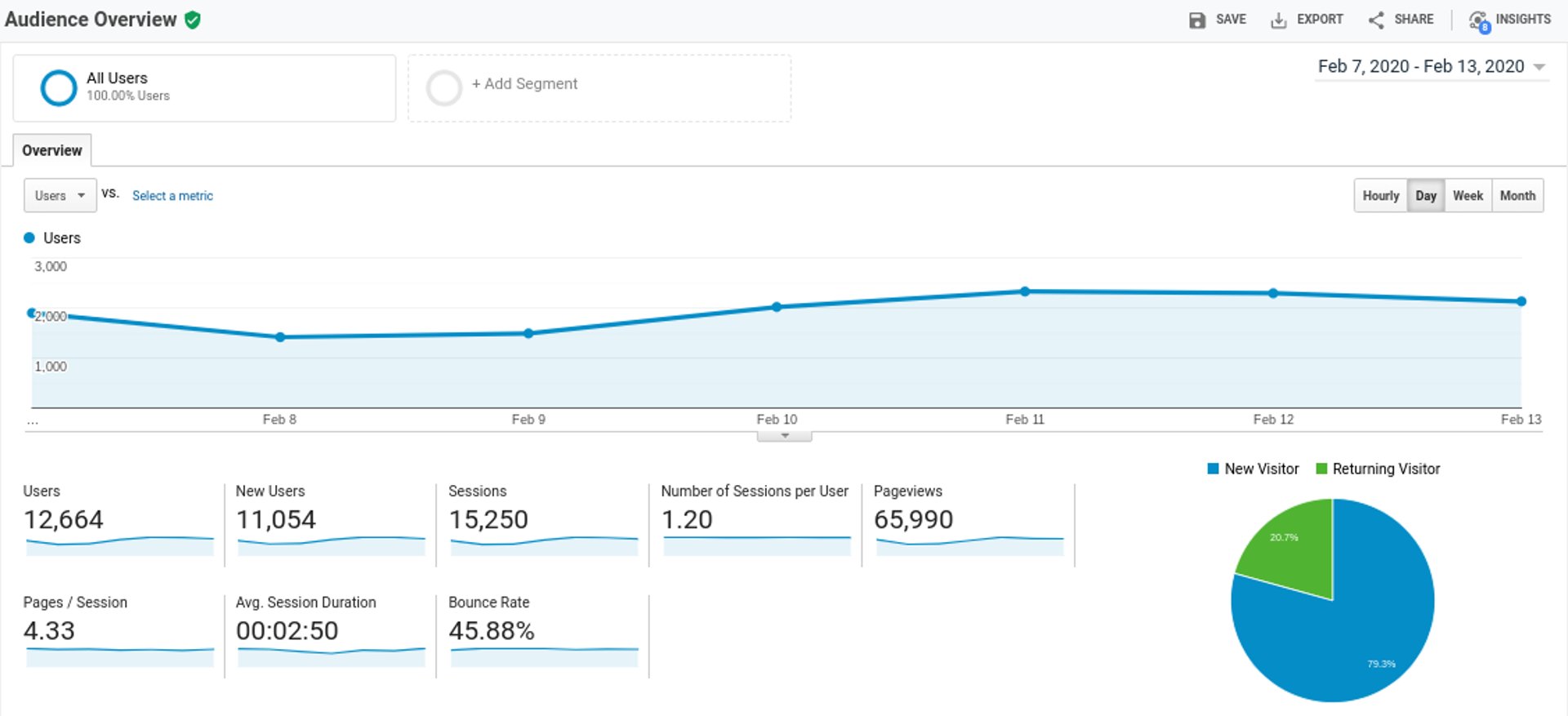
Here, you should also take note of the bounce rate which shows the percentage of visitors that leave without visiting a second page.
To see where your traffic comes from head to Acquisition > All Traffic > Channels:
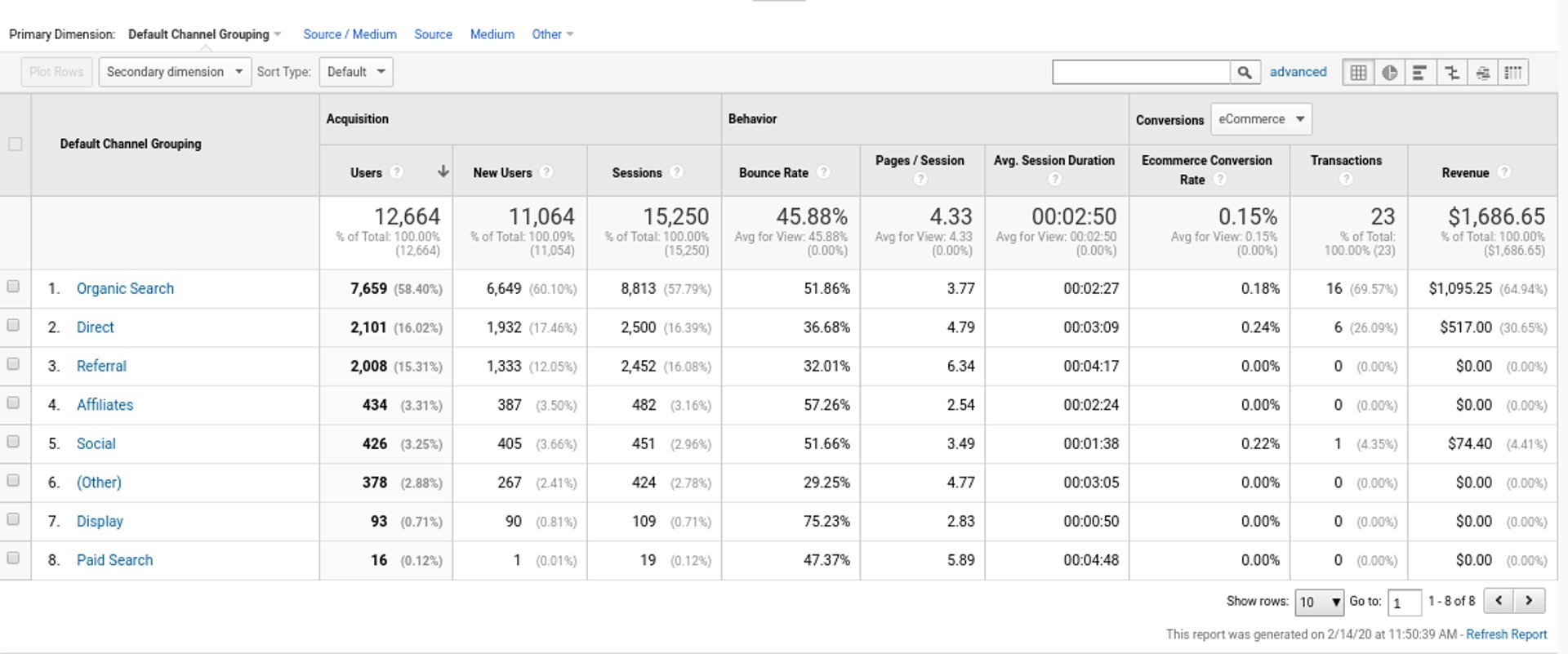
Here you can compare the performance of traffic sources against other aspects such as bounce rate and goal completions.
Now, the question is, what do you do with this information? Firstly, it makes sense to do more of what’s working for you. For instance, if you see a lot of social traffic, double down on your social media marketing to acquire even more visitors.
You also need to consider what isn’t working. Perhaps, you put a lot of effort into on-page SEO but still aren’t getting as much organic traffic as you would like. This means your current SEO strategy isn’t working, so you need to switch it up.
Finally, you should experiment with further acquisition channels. You may find an untapped channel that increases traffic to your e-commerce site. For example, you may wish to try Google Shopping or partner with influencers.
The trick is to continue to monitor where your traffic comes from and tweak your strategy accordingly.
2. Cart Abandonment
Cart abandonment rate is the rate at which users add items to their cart and leave without making a purchase. Naturally, this is significant as it means a potential sale lost.
On average around three out of four users abandon their carts. How does your e-commerce store measure up?
If your cart abandonment rate is high, it could mean that there are frictions on your site, app or platform which prevent users from making a purchase. And it’s important to continually monitor this to check whether your methods of reducing cart abandonment are working.
Enable enhanced e-commerce in Google Analytics to track your cart abandonment rate. Do this in Admin > View > E-commerce Settings.
Once you have it enabled, head to Conversions > E-commerce > Shopping Behavior. Here you will find your cart abandonment rate and check-out abandonment rate:

It’s a useful chart which indicates exactly where visitors drop out of your funnel.
The best way to reduce your cart abandonment rate would be to remove any barriers that stop a purchase. The top three reasons for cart abandonment are added costs, compulsory account creation and a complicated checkout process:
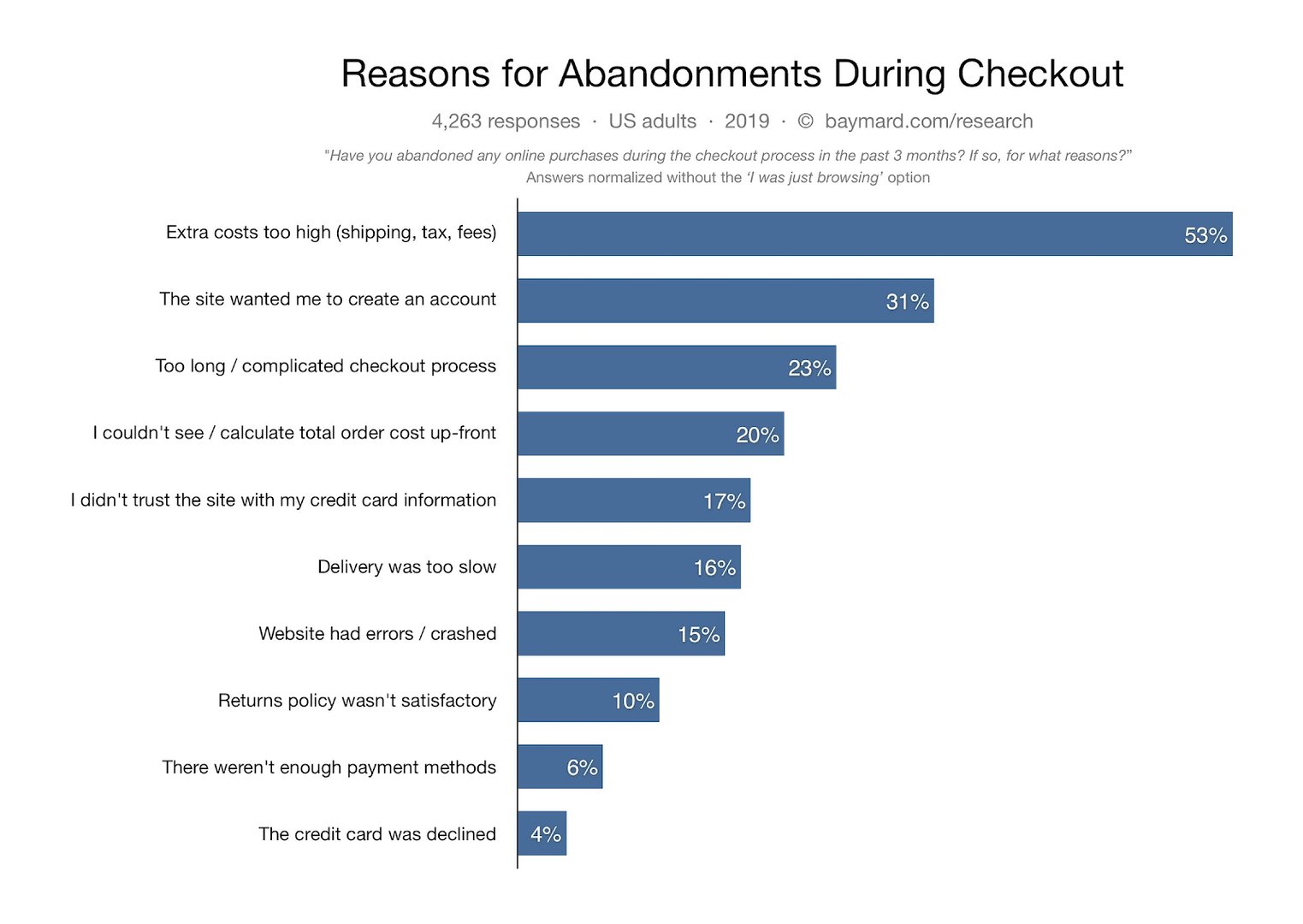
It would be a good idea to test solutions to these common pain points. For instance, you could reduce shipping costs or reduce the threshold for free shipping.
If you don’t see a decrease in cart abandonment rate then test another solution, such as allowing guest purchases so users don’t have to create an account.
To pinpoint the exact barriers that cause cart abandonment, you could try performing user tests. Screen recordings, for example, show where users run into problems in real-time.
Another strategy would be to remind users that they have left items in their carts. Use an exit-intent pop-up to increase the likelihood of a purchase, like this one:
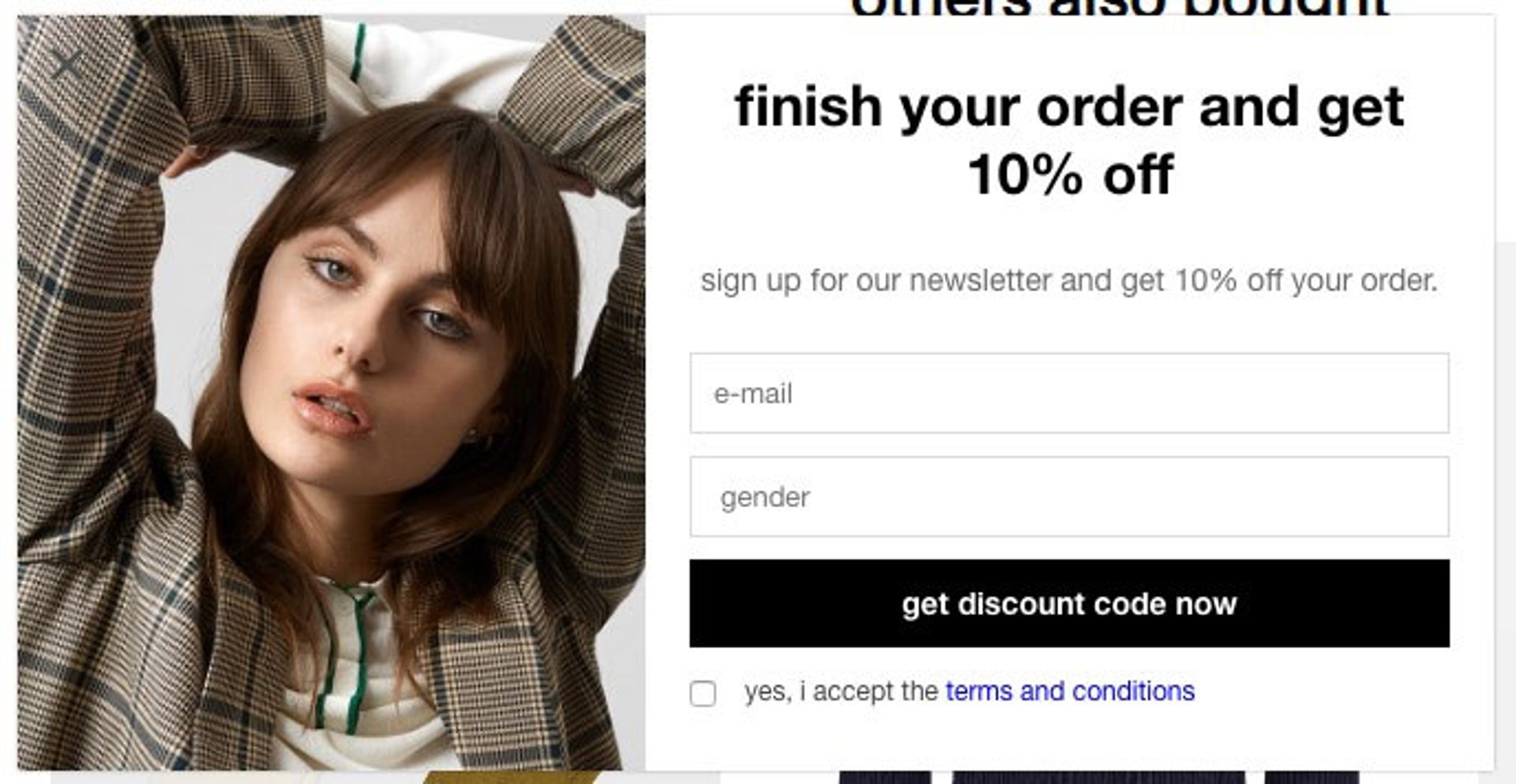
Alternatively, you can send out a reminder email, like this one:

There are lots of opportunities to remarket to customers. These are just some of the most effective ways to get consumers back on board.
3. Average Order Value (AOV)
Average order value represents the average amount spent per customer. If you can increase this value then you can increase your profits without having to acquire tons of new customers.
You might be wondering what a good AOV looks like. Well, the truth is, there are differentiating factors, for example the industry you’re in or device used. But here's some recent benchmark data:

The benchmark for desktop is $128.08 and mobile is $86.47.
To find out how your AOV compares, go to Conversions > E-Commerce > Overview in Google Analytics:

You can also see AOV according to source. Head to Acquisitions > All Traffic > Channels and click the e-commerce tab at the top:

This is useful as it shows you which acquisition channels result in the highest average spend. If your goal is to increase AOV then you can invest more time and resources into those channels.
Other methods of increasing AOV involve optimizing your e-commerce store. One super effective method is to upsell products on your site. This means offering upgraded items at a higher price point. Here you can see that Dell offers a premium version of the same laptop:
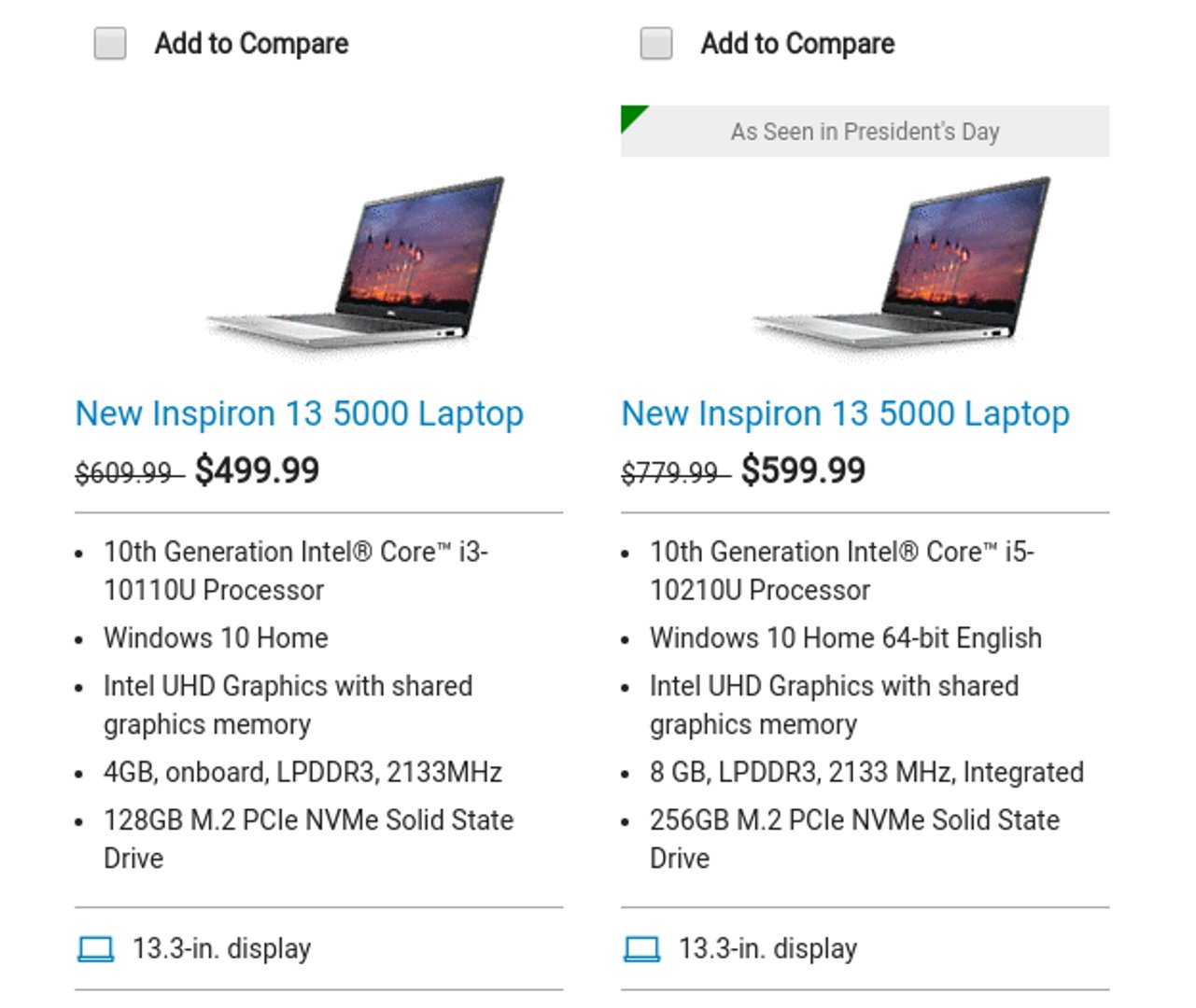
The one on the right costs more because it has more RAM and storage etc.
Another way to increase AOV would be to cross-sell items. This is when you recommend related products or add-ons to increase the overall spend. Here, Target recommends you add replacement brush heads and further related items when you purchase an electric toothbrush:
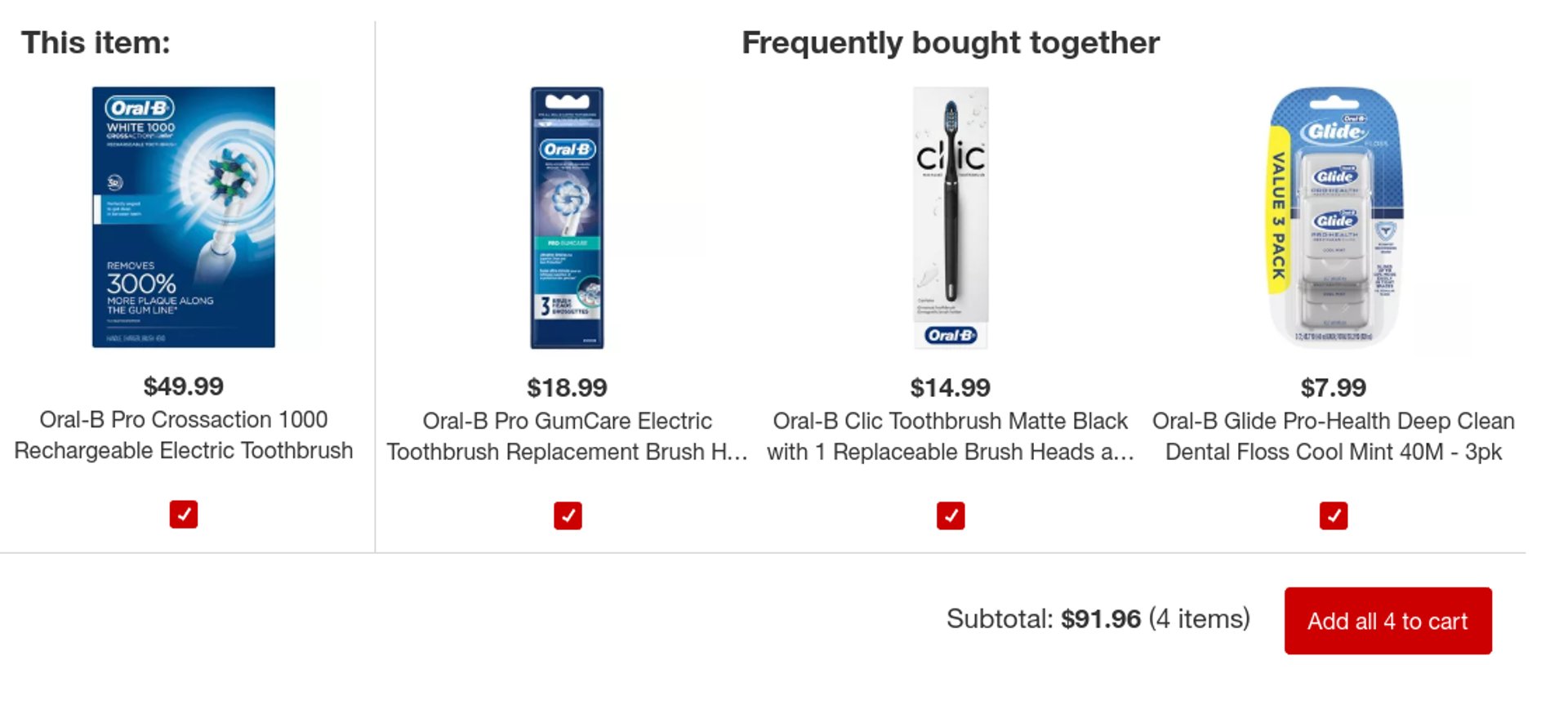
Another commonly-used tactic is to clearly display the minimum spend thresholds. For instance, when the customer spends a certain amount they get a discount, offer, freebie or free shipping. Here’s an example from TopShop:
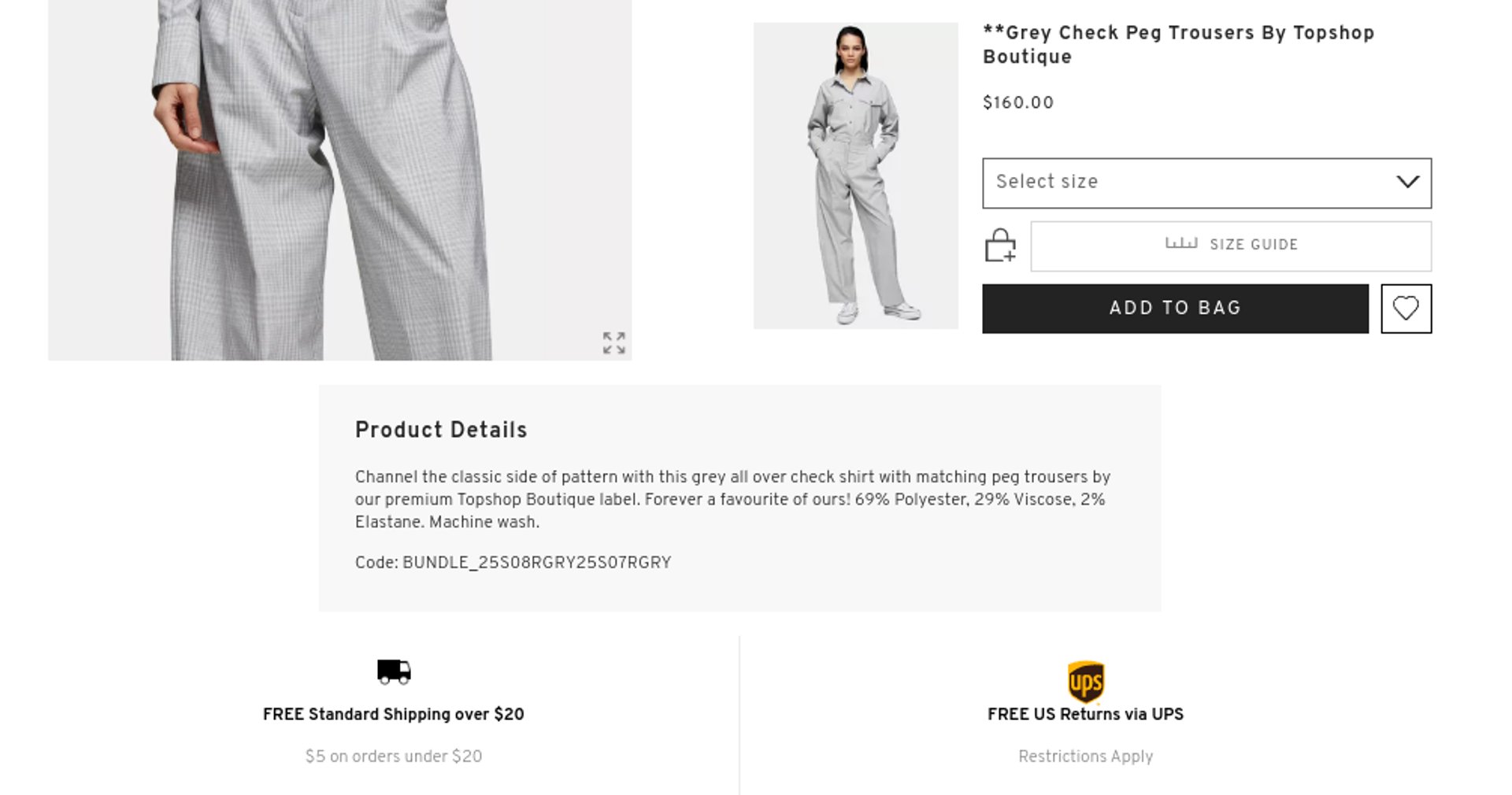
They encourage a minimum spend of $20 in order to get free shipping.
If you try some of these tactics and manage to increase AOV, you can get the most out of every customer that buys from you.
4. Conversions
Though it shouldn’t be your only KPI , increasing conversions is no doubt your number one goal. But as I’m sure you’re painfully aware, this is difficult to achieve. Did you know that the average conversion rate of online shoppers globally is only 2.58–3.23 percent?
By tracking conversion rates, you get to see how your marketing and sales efforts are working overall. There’s a bunch of data you can view in the e-commerce section of Google Analytics to check if you are meeting your sales targets. This includes revenue, conversion rate, product performance, sales performance and more.

You can also set up and track specific conversion goals. In Analytics go to Admin > View > Goals and click +New Goal. You’ll then see a list of ready-made templates:

If your objective is to boost sales then you’d choose “Make a payment” or set up a custom goal. Alternatively, you could monitor micro-conversions, such as email signups.
Once you have your goal set up you will be able to see how all of your metrics relate to your conversion goals within Analytics. So, not only do you get an idea of your business performance, but you can dig deeper into what drives sales. For instance, you could check which landing pages or acquisition channels get the most goal conversions. Of course, you’d then use this information to your advantage.
And don’t forget that your other KPIs affect your conversion rate significantly. More traffic means more leads; fewer abandoned carts mean more sales and so on.
You should also try experimenting with new sales strategies. There are hundreds of tried and tested strategies. But, it helps to pay attention to e-commerce trends.
For instance, many stores now use AI to enhance the shopping experience and help customers find what they’re looking for faster. MeUndies has a help assistant which suggests FAQs related to the product or page:
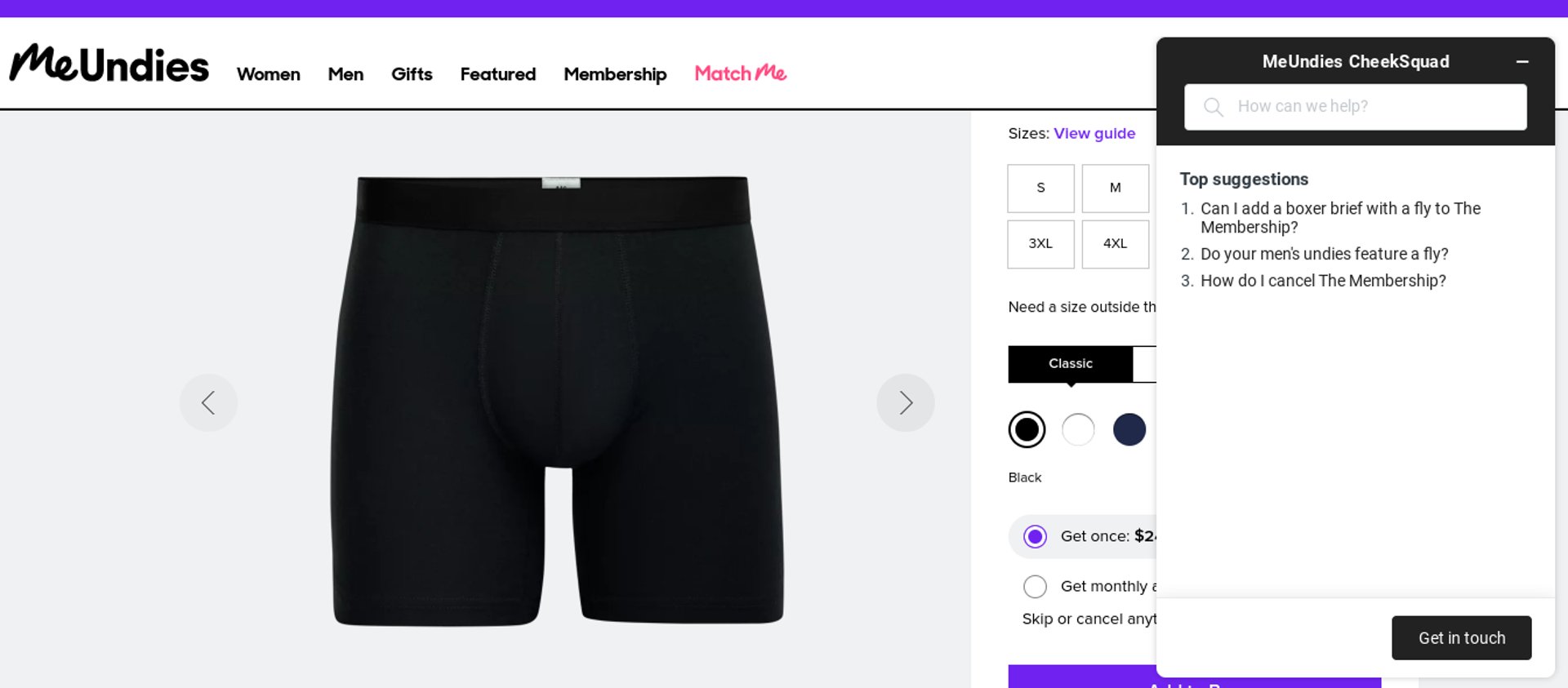
Another trend on the rise is voice search. If you want your products to pop up first when consumers ask “Hey, Google…” then you should certainly optimize your e-commerce store for voice search.
Whether you employ cutting-edge sales strategies or simply tweak your existing strategy, make sure you monitor your conversion rate to see the results.
5. Customer Lifetime Value (CLV)
Customer lifetime value is the amount of revenue you can expect to receive from a customer throughout their entire relationship with your brand. Naturally, you want customers to keep coming back for more. And the longer they continue to buy from your store, the greater their value.
Compared to B2B, it can be difficult to build long-term relationships with customers in e-commerce. B2C purchases are often emotionally-driven and made on impulse.
But if you can create loyal, returning customers, you’ll reap the rewards. Existing customers spend 67 percent more on average than new customers.
Google Analytics has a lifetime value report. Simply head to Audience > Lifetime Value.
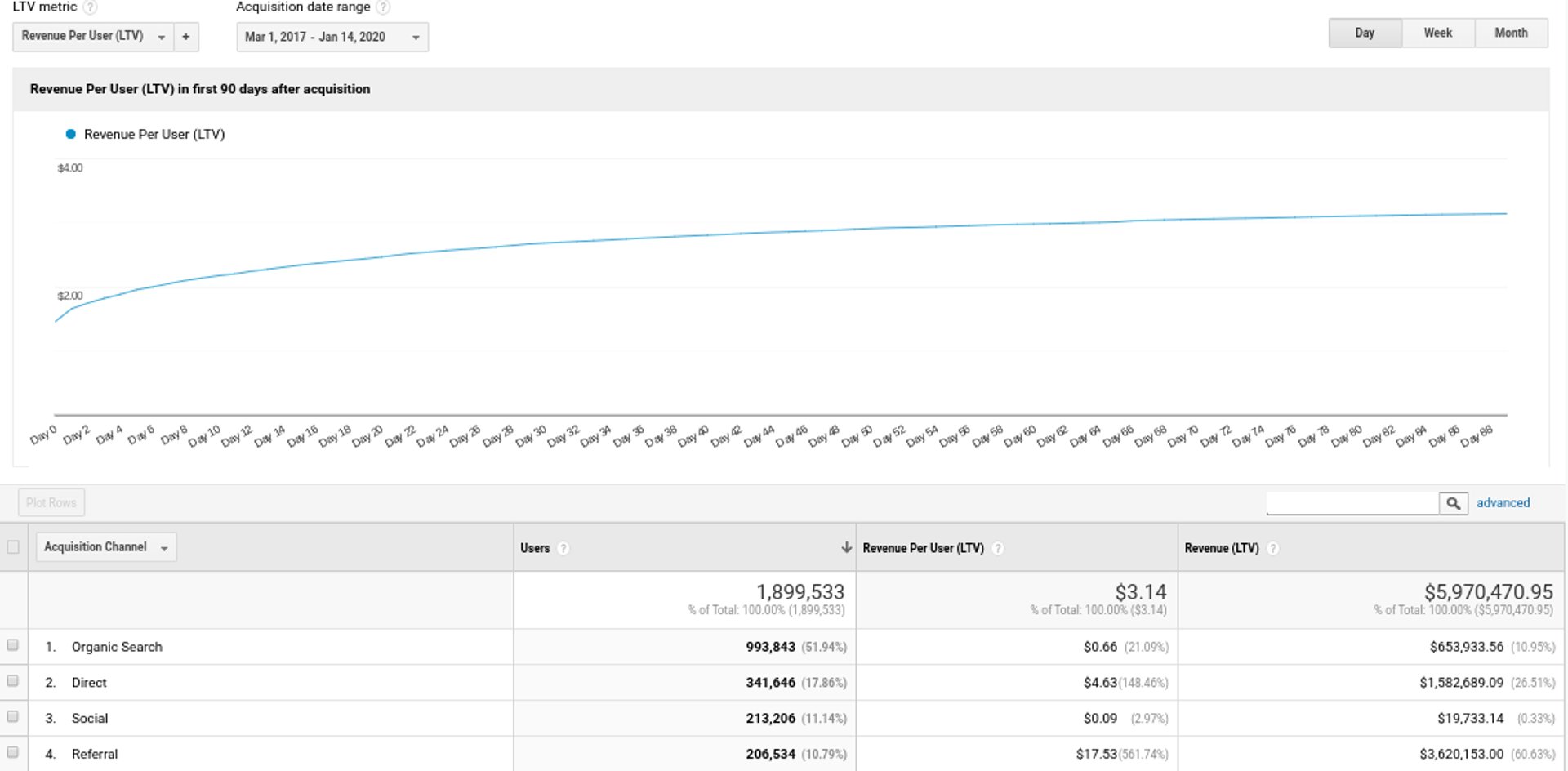
You get to set the parameters so that you can see revenue per user in a given time period. And you can use this report to establish which marketing channels bring the highest value customers.
Work out the value of a customer compared to the cost of acquiring them. This will inform your acquisition strategy. For example, if SEO has minimal pay-off for you then you can invest your resources in other channels that create more valuable customers.
The best way to increase CLV across the board is to focus on customer experience and customer retention.
Satisfied customers that have had positive experiences with your brand are more likely to make another purchase. Customer service is important here. Consumers expect a fast and helpful response to their queries and complaints across multiple channels.
To retain valuable customers, you should provide an experience that goes above and beyond. For instance, you could create a loyalty program to reward your best customers. The North Face has a tiered reward system for this purpose:
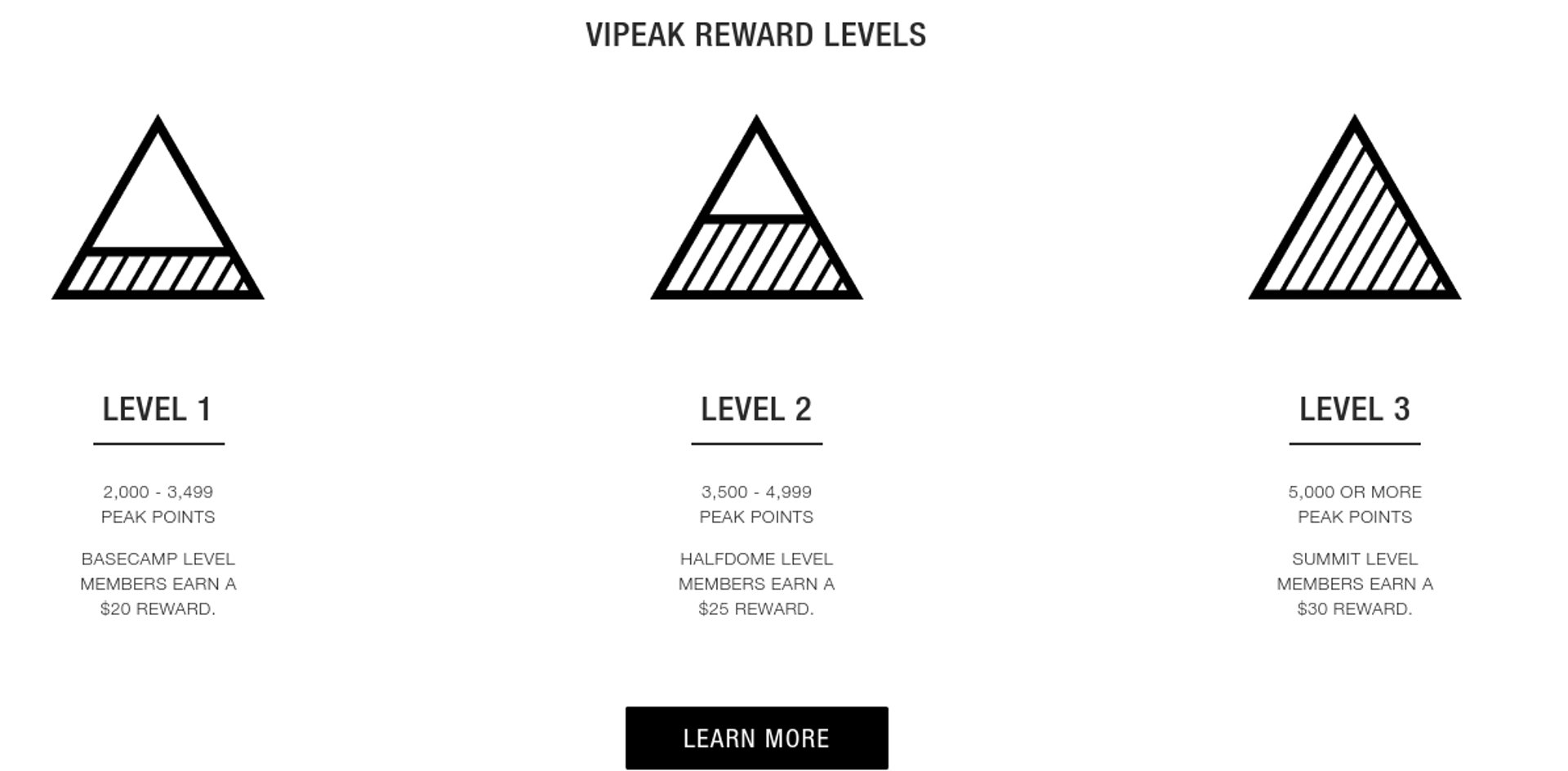
Another way to encourage customer loyalty is to engage them with useful content. Essentially, you teach users how to get the most out of your products and show them that they are gaining value from their relationship with your brand. In this email, Barebones shows how you can have an awesome experience with their products in real life:

All in all, CLV is certainly worth paying attention to. If you can increase CLV, then you raise your total revenue.
Summary
It’s important to establish your business goals, track metrics to measure how successful your e-commerce store is and optimize performance. Hard data helps you come up with more successful strategies.
Here are the top five KPIs for e-commerce businesses and how to utilize the data:
1. Traffic. Optimize your marketing and advertising efforts to get more site visitors.
2. Cart Abandonment. Uncover problems that prevent customers from completing a purchase.
3. AOV. Find the channels which bring big spenders to your site.
4. Conversions. Work out how to drive more sales.
5. CLV. Tweak your acquisition strategy, plus bring in more high-value customers.
Furthermore, you can use the tips and tactics in this post to make improvements to your key metrics. Because working on these KPIs is an effective and efficient way to reach success.
Related Articles

How to Build Google Analytics 4 Dashboards in Klips
By Jonathan Taylor — June 6th, 2023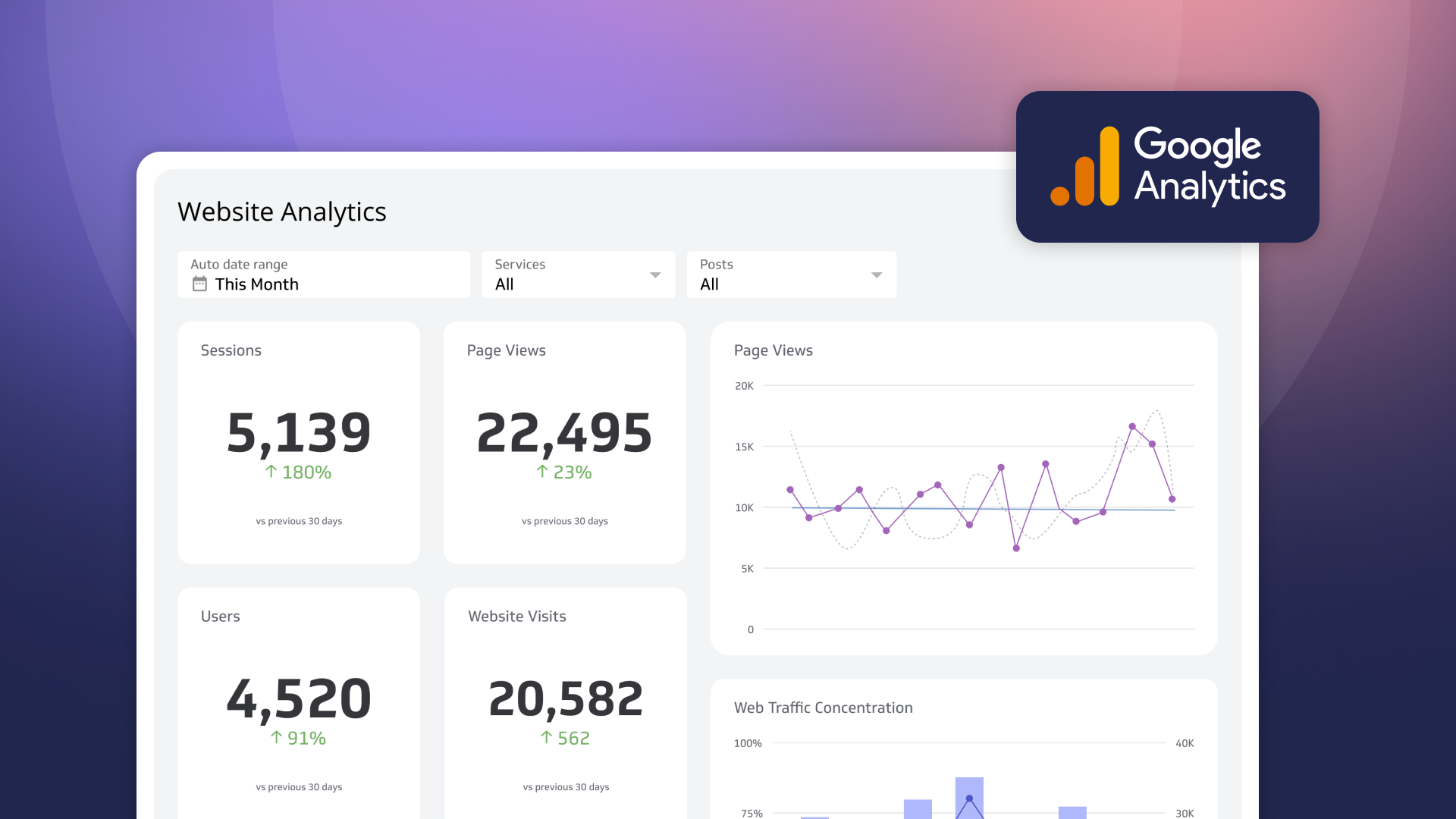
How to use the Google Analytics 4 Query Explorer to export data
By Jonathan Taylor — June 1st, 2023
You've spoken and we've heard you - The re-launch of Klipfolio Desktop
By Parker Selman — April 1st, 2023

